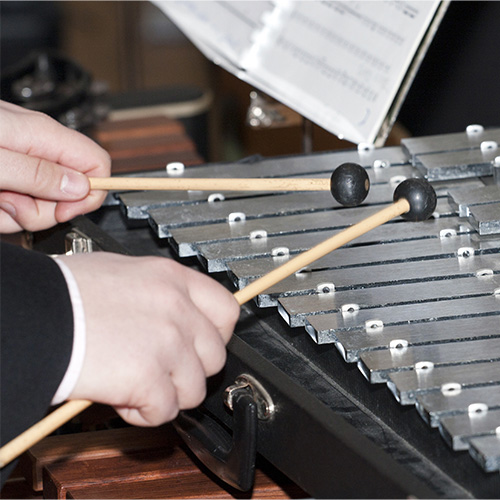Y1. Lesson 8. High & low sounds II
Prior learning: High & low sounds
Duration: 30 minutes
Materials: Woodblocks or claves
Keywords: Beat, rhythm, singing, chanting, partners, rhymes, circle games.
Difficulty: ![]()
Prepare
ta & ti-ti
Present
Practise
High & low sounds, beat
 Melodic development
Melodic development
![]() Students discover a sequential series of rising and descending sounds in this amusing song.
Students discover a sequential series of rising and descending sounds in this amusing song.
- This is a wonderful song to practice high and low sounds (pitch) and for students to have a lot of fun.
- Stand and sing the song to the students and then sing it phrase by phrase, asking them to echo after you.
- Start by pointing to your foot and sing the first half of the song, and have your hand move upwards, past your tummy, past your nose and come to rest on your head.
- Repeat and ask the class to stand and sing with you, ensuring students keep in tune and make the correct hand actions.
- Now reverse the actions as per the lyrics.
- The actions you make showing the 'flea' rising up and down your body will make children laugh and serve as a great visual representation of high and low sounds.
 Questions
Questions
- Did the sounds get higher or lower as the flea went up your body?
- What about on the way down? What did the sounds do?
- Do you think the flea in the song could really go up and down, or is it just a fun story?
 Rhythmic development
Rhythmic development
![]() Students explore loud and soft and pitch contour by chanting and moving their arms in a circle.
Students explore loud and soft and pitch contour by chanting and moving their arms in a circle.
![]()
Roly poly, roly poly, up, up, up.
Roly poly, roly poly, down, down, down.
Roly poly, roly poly, out, out, out.
Roly poly, roly poly, in, in, in.
- Speak in a measured cadence to keep the beat. Teach the class the lyrics while showing the circling movement in your arms.
- It is essential never to let the movement stop as you raise your arms up and down, as well as in and out.
- For the first half of the rhyme, raise your voice in pitch incrementally as you move your arms up and lower it as you move your arms down.
- For the second half, you can make your voice louder as you move your arms out and softer as you move them in.
- This rhyme and its corresponding actions help teach students the rudiments of both pitch and dynamics.
 Creative movement
Creative movement
![]() Students expand the concepts of loud and soft by singing a song softly and then loudly.
Students expand the concepts of loud and soft by singing a song softly and then loudly.
- Place a battery-powered candle prop on a table and ensure it is illuminated.
- If the class has not learned this song, teach it line-by-line in a measured cadence until secure.
- Sing the song to the class in a soft and gentle tone. When you have finished, turn off the candle.
- Ask students to repeat the song along with you quietly.
- Again, turn off the candle prop. Explain that they were singing the song softly.
- Sing the song loudly, ask the class to repeat after you in a louder voice, and turn off the candle at the song's end.
- Explain that they were singing the song loudly.
- Ask students which singing they liked the best - loud or soft.
- Extension: Students stand in a circle and pass a candle prop around on the beat. The student it lands on for ‘out’ sits out for the remainder of the game.
 Listening
Listening
![]() Students use tuned percussion to further their understanding of high and low notes.
Students use tuned percussion to further their understanding of high and low notes.

- Bring a student to the front and, using a xylophone, glockenspiel, or another tuned percussion instrument, guide them to play a low note followed by an octave higher note.
- Have the class identify which note was low and which was high.
- Repeat with another student, instructing the class to crouch for low sounds and stretch up for high sounds.
- Demonstrate high and low sounds using arm movements: touch heads for high sounds and shoulders for low sounds.
- Have students practice identifying high and low sounds while following the corresponding arm movements.
- Continue with additional students as time allows, reinforcing the concepts of high and low sounds and their associated physical representations.
 Visual learning
Visual learning
![]() Students sing and point to icons while keeping the beat.
Students sing and point to icons while keeping the beat.
- Project the beat icons.
- Students are seated and attentive
- Sing the song with the class, pointing to each icon on the beat.
- Students should keep the beat on their knees, shoulders or heads.
- When secure, ask a volunteer to point as the class sings.
- Repeat as time permits.
- This exercise reinforces students' development of beat by using visual cues.
 Instruments
Instruments
![]() Students use a variety of untuned percussion instruments and discover new ways to make sounds.
Students use a variety of untuned percussion instruments and discover new ways to make sounds.
- Distribute tambourines, woodblock, guiros and egg shakers (or similar classroom instruments).
- Using the worksheet, ask students to explore the sounds and methods of playing these instruments.
- The idea is to have students experiment with the sounds and techniques, however unorthodox, of these instruments to discover new and interesting sounds.
- Towards the end of this activity, start playing the beat on an instrument and have everyone join in with theirs.
 Part work
Part work
![]() Students keep the beat and use creative movements, varying the original lyrics.
Students keep the beat and use creative movements, varying the original lyrics.
![]()
This is the way we tap our heads,
Tap our heads, tap our heads.
This is the way we tap our heads,
When we sing this song.
This is the way we clap our hands,
Clap our hands, clap our hands,
This is the way we clap our hands,
When we sing this song.
This is the way we slap our thighs,
Slap our thighs, slap our thighs.
This is the way we slap our thighs,
When we sing this song.
This is the way we stamp our feet,
Stamp our feet, stamp our feet.
This is the way we stamp our feet,
When we sing this song.
- If students are secure with Mulberry Bush, inform them that they will invent new lyrics and movements for the song. Use a piano track or sing to maintain the beat.
- Arrange students in a circle and instruct them to follow your lead, tapping their heads to the beat.
- Sing the first new verse while tapping your head and encourage students to mimic your actions.
- Once students are confident, introduce the next verse and explain that they should clap to the beat while singing the new lyrics.
- Continue this process for the subsequent verses, ensuring students understand and execute the movements accurately.
- This activity adds variety and reinforces rhythmic understanding through physical engagement.

 Assess
Assess
Suggested lessons
Y1. Beat II

Y1. Beat III

Y1. Beat IV

